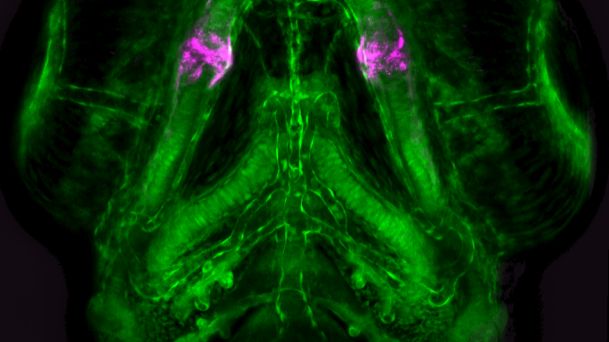
Press release -
DNA sequence enhances understanding origins of jaws
Researchers at Uppsala University have discovered and characterised a DNA sequence found in jawed vertebrates, such as sharks and humans, but absent in jawless vertebrates, such as lampreys. This DNA is important for the shaping of the joint surfaces during embryo development.
Peer review/Experimental study/Zebrafish
The vast majority of vertebrate species living today, including humans, belong to the jawed vertebrate group. The development of articulating jaws during vertebrate evolution was one of the most significant evolutionary transitions from jawless to jawed vertebrates, taking place at least 423 million years ago. The lower and upper jaws were initially connected by the primary jaw joint. However, during the evolution of mammals this moved to the middle ear to enhance hearing and was replaced by the secondary jaw joint, which is how humans are constructed today.
The primary jaw joint is formed during embryonic development and has an active gene which contains sequence information for a specific protein – transcription factor Nkx3.2. This protein has long been thought to have played a major role in the evolution of this jaw joint, but little was known before about how its gene activity is regulated in the jaw joint cells.
Typically, genes are activated with help from DNA sequences, known as enhancers, that do not contain gene sequence information. Furthermore, such ‘regulatory’ DNA can contribute to the activation of the gene only in a certain cell type and can be conserved among different animal species.
“We searched through the genome sequences of many different vertebrate species and only found the DNA sequence near the Nkx3.2 gene in jawed vertebrates – not in jawless ones. When we injected these DNA sequences from jawed vertebrates into zebrafish embryos, they were all activated in the jaw joint cells. The fact that their ability to activate has been preserved for over 400 million years shows how important it is for jawed vertebrates,” notes Tatjana Haitina, researcher at Uppsala University, who led the study.
“In experiments where we deleted the newly discovered DNA sequence from the zebrafish genome using the CRISPR/Cas9 technique, we saw that the early activation of the Nkx3.2 gene was reduced, which caused defects in the jaw joint shape. It turned out that these defects were later repaired, suggesting that there is additional regulatory DNA somewhere in the genome that controls the activation of the Nkx3.2 gene and is waiting to be discovered,” adds Jake Leyhr, doctoral student student in the research team.
The researchers hope that their discovery is an important step towards eventually understanding the process behind the origins of vertebrate jaws.
The study was conducted in collaboration with SciLifeLab’s Genome Engineering Zebrafish and BioImage Informatics units.
Leyhr et al. (2022) A novel cis-regulatory element drives early expression of Nkx3.2 in the gnathostome primary jaw joint, eLife 11:e75749, DOI: https://doi.org/10.7554/eLife.75749
For more information, please contact:
Tatjana Haitina, Researcher at Department of Organismal Biology, Uppsala University, tatjana.haitina@ebc.uu.se Tel. +46 18-471 61 20
Funding was received from the Swedish Research Council and SciLifeLab.
Topics
Categories
Uppsala University is the oldest university in Sweden, founded in 1477, and is ranked among the world’s top higher education institutions. We are a comprehensive research-intensive university with a strong international standing and a clear mission: To pursue top-quality research and education and to interact constructively with society. At the heart of this mission is the endeavour to advance sustainable development, engage with the wider community, and promote openness and respect. Our most important assets are all the individuals – over 54,000 students and more than 7,500 employees – who enrich the university with their curiosity and dedication. www.uu.se

